The great outdoors is always right around the corner.
However, going out without a plan for powering devices is impractical these days. Portable solar panels provide a simple solution to the problem.
The issue then becomes picking the correct one for your camping adventures.
In the table below, I summarized my top five picks for camping solar panels. In total, they go from 21 watts all the way up to 100 watts of power.
Due to the difference in power, the panels naturally vary in weight and size. The 100W panels also vary in weight due to their materials.
| Solar Panel Ranking | What Makes It Unique? |
|---|---|
| 1. Best Overall – Rockpals 100W Foldable Solar Panel | – Avg. 4.7/5 on Amazon based on over 2,000 ratings – Comes with multiple adapters for devices – 3x USB ports in addition to a DC port – Inexpensive |
| 2. Best Small Panel – BigBlue 3 USB Ports 28W Solar Charger | – 3x USB ports – Small enough to attach to a backpack; powerful enough to charge 3x devices |
| 3. Best Value – Nekteck 21W Portable Solar Panel | – Over $20 less than the competition (Anker) – Lightweight (1.12 lbs) |
| 4. Most Compact – ALLPOWERS 100W Portable Solar Charger | – Can fit in a backpack (uncommon for 100W panels) – 2x USB ports in addition to a DC port – Lightest 100W panel on this list by far (5.23 lbs) |
| 5. Most Robust – Goal Zero Boulder 100 Briefcase | – High-quality materials (aluminum frame & tempered glass) – Has kickstand to angle panel |
Below are some of the basic specifications of each selection in this post.
| Ranking | |||||
|---|---|---|---|---|---|
| Model | Rockpals 100W Foldable Solar Panel | BigBlue 3 USB Ports 28W Solar Charger | Nekteck 21W Portable Solar Panel | ALLPOWERS 100W Portable Solar Charger | Goal Zero Boulder 100 Briefcase |
 |
|||||
| Watts | 100W | 28W | 21W | 100W | 100W |
| Weight | 10.8 lbs | 1.35 lbs | 1.12 lbs | 5.29 lbs | 25.9 lbs |
| Folded Size | 20.5 x 14.2 in | 11.1 x 6.3 in | 6.3 x 11.1 in | 12.6 x 7.5 in | 26.8 x 21.8 in |
| Best Price | Amazon | Amazon | Amazon | Amazon | Amazon |
If you’re looking for solar panels designed specifically for recharging cell phones and smaller devices, I recommend checking out my other blog post dedicated specifically to this topic.
I discuss FAQs on using solar power to recharge your cell phone, plus, I give my top three portable solar panels for this purpose.
1. Rockpals 100W Foldable Solar Panel (SP003)
Specs
- Weight: 5.1 pounds
- Size (Folded): 20.5 x 14.2 x 2.6 in
- Size (Unfolded): 64.5 x 20.5 x 1.2 in
- Wattage: 100W
- Solar Efficiency Values: 21.5% to 23.5%
Key Features
Rockpals foldable solar panels are designed to work with both solar generators and individual devices.
The panels come with a wide variety of connectors for the various solar generators. The junction box also contains three USB ports equipped with quick charge and intelligent device recognition powered by TIR-C.
The panels themselves fold up into a briefcase-sized package. The panels are waterproof, and the cover is water-resistant. The junction box must be kept dry for safety.
The panels offer enough surface area to be effective even on cloudy days.
Pros
- The three built-in USB ports offer you the option to charge handheld devices quickly.
- Plugging this panel into a small solar generator can create enough power to charge devices for everyone in your crew.
- The pouch containing the ports can store all the necessary cables and connectors, so they’re never separated from the panels.
- Lightweight and collapsable for on-the-go use.
Cons
- When folded, the panels are the size of a briefcase. This feature makes them suitable for car-based excursions, but not backpacking.
- The panel doesn’t have a kickstand, so it may be difficult to get the ideal angle towards the sun.
2. BigBlue 28W Solar Charger
Specs
- Weight: 23.8 oz
- Size (Folded): 11.1 x 6.3 x 1.3 in
- Size (Unfolded): 33.1 x 11.1 x 0.2 in
- Wattage: 28W
- Solar Efficiency Values: 21.5% to 23.5%
Key Features
This BigBlue solar charger checks many of the boxes necessary for highly portable solar panels. The panels carry CE, FCC, and RoHS certifications, meaning they’ve passed rigorous safety inspections.
There are four buckles for easy attachment just about anywhere. The panels also offer built-in current protection and smart charging as extra safety measures for the charging devices.
The design itself is designed to be both rugged and useful. The panels have a PET polymer coating for water repellency, while the case offers IPX4 standard-level waterproofing.
The three USB hubs are located inside a pocket that works with a waterproof port protector to keep everything running.
Pros
- The BigBlue solar charger is both lightweight and rugged.
- The built-in hooks make it easy to attach to backpacks.
- Its folded dimensions make it easy to store in the pack or on the carabiner hooks once everything is fully charged.
- This solar charger is specially designed for handheld devices including phones, rechargeable headlamps, etc.
Cons
- Limited compatibility – This solar charger does not connect to any sort of solar generator or any battery that does not have a USB connection.
- It also does not work well when charging bigger devices, such as tablets and laptops.
- The pouch which houses the USB ports is secured with a small Velcro patch that doesn’t completely seal the storage pocket.
3. Nekteck 21W Portable Solar Panel
Specs
- Weight: 1.12 pounds
- Size (Folded): 6.3 x 11.1 x 1.1 in
- Size (Unfolded): 26.4 x 11.1 x 0.7 in
- Wattage: 21W
- Solar Efficiency Values: 21% to 24%
Key Features
This Nekteck portable solar panel is designed to be rugged, with a PET polymer cover and waterproofing that meets IPX4 standards.
It’s also designed to be lightweight and compact. The foldable panel and sturdy attachment points make it perfect for outdoor adventures.
The solar panel connects to your devices through two USB ports built into the design. These ports have smart IC technology.
Smart IC recognizes what devices are connected and charges them at their optimal rate when possible. This technology is all built into an easy-use pouch in the canvas cover.
Pros
- Nekteck portable solar panels are lightweight, which is beneficial regardless of your planned adventures.
- Portable – It can fit in your backpack when folded and be used to charge your devices on the outside of your backpack when unfolded.
- Comes with clips to hang on your backpack or any area you see fit for charging.
Cons
- Slow charging – This panel is small and is likely to output only enough power to charge one device at a time.
- The USB ports within its storage pocket are positioned awkwardly (they face the zippered opening), which may make it difficult to charge devices within the pocket.
4. ALLPOWERS 100W Portable Solar Charger
Specs
- Weight: 5.29 pounds
- Size (Folded): 12.6 x 7.5 x 3.6 in
- Size (Unfolded): 37 x 37 x 0.39 in
- Wattage: 100W
- Solar Efficiency Values: up to 23.5%
Key Features
The ALLPOWERS solar panel offers PET panels sewn into durable canvas fabric. The unique feature of this device is the way the solar panels are laid out.
Rather than having large solar cells, the design incorporates a higher number of smaller panels. This choice makes the solar charger incredibly foldable and easy to carry.
While the overall design is lightweight, the outputs are versatile. The device offers two USB ports and a DC output.
Included in the package are a variety of connectors, ranging from a car battery to a cigarette lighter adapter to various laptops.
That kind of diverse usability makes it an excellent option for outdoor adventures. The solar charger can also be compatible with solar generators.
This ALLPOWERS solar charger features iSolar technologies. This technology allows the charger to sense the device on the other end of the connector and supply power in the way that charges that device fastest.
Since you can choose to charge a cell phone from the 100-watt panel, it is important, so the device does not overload.
The overall design is highly foldable. It is also dust and water-resistant, which is useful for the great outdoors. The solar charger has several eyeholes and loops for easy attachment, whether that’s a tent side or a backpack.
Pros
- The availability of direct charging ports is useful for powerful solar panels. It allows the device to operate without a solar generator.
- Portable – This is one of the only 100W solar panels that, when folded, can fit into a standard backpack.
- Efficient charging – Its two USB ports and 18V DC port are equipped with an intelligent charging chip, which adjusts the voltage and current to best support your device when charging.
- The basic package includes ten laptop connectors, DC 5.5×2.5 mm to 5.5×2.1 mm cable, USB cables, carabiners, and a car port plug. This combination is both useful and easy to work with, whether it’s personal electronics, laptops, or generators.
Cons
- The biggest issue with this product is what allows it to be so foldable. There is no robust framework for the solar charger.
- This feature makes putting the cells at a significant angle to catch sunlight difficult. While they do work well on the ground, that position does not offer maximum solar efficiency, and charging may suffer.
5. Goal Zero Boulder 100 Briefcase Solar Panel
Specs
- Weight: 25.9 pounds
- Size (Folded): 26.8 x 21.8 x 3.8 in
- Size (Unfolded): 26.8 x 43.5 x 1.75 in
- Wattage: 100W
- Solar Efficiency Values: up to 23%
Key Features
The Boulder 100 is a solidly built pair of solar panels hinged together for maximum power. The panels are made of tempered glass and mounted on a lightweight aluminum frame.
The modules come with removable kickstands for proper angling without the hunt for the right-sized rock to lean them against. The panels also come with a built-in handle.
The package also includes a carry case for even more mobility. The Boulder 100 panels take a no-frills approach to panels, so no extra wires are hanging around or bulky controllers.
The panels are specifically designed to work with other Goal Zero products, so the 8mm connector fits snugly and securely with them. Goal Zero designed the panels to work alone or in parallel for even more power.
Pros
- Safer to use in adverse outdoor weather than the other options in this list since it’s made from tempered glass and aluminum.
- Can be connected to multiple Boulder 100s for a faster charge.
- Versatile – You can use the kickstand to charge up efficiently. Plus, it can be mounted on a car or roof since it’s made of durable materials found in standard rigid solar panels.
Cons
- The Boulder 100 is specifically designed to work with other Goal Zero portable power stations, so you can’t use the panel to charge any other device directly.
- The kickstands can also be slightly problematic. The locking position for the panels when open is only 45 degrees. While this works well in many locations, it is not a universal position. In many areas, the angle for optimal sunlight capture is higher.
- Heavy – At 26 lbs, the Boulder 100 BC is still technically portable, but only for short distances.
How much solar power do I need for camping?
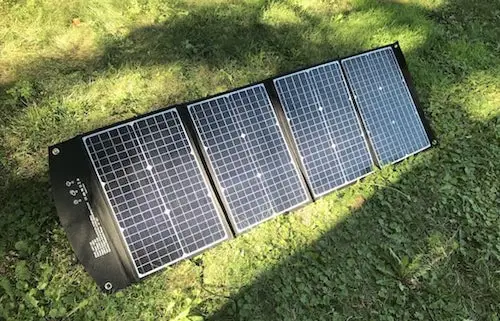
The typical amount of solar power needed for camping varies from 20-50 watts. A solar panel in this output range can recharge multiple small devices during the day. If more power is needed to run an appliance like a camping fridge, then a 100-200W panel along with a portable power station is ideal.
A solar panel for camping should be powerful enough to keep your battery and/or devices fully charged throughout the day.
This is done by estimating your daily power consumption (in watt-hours) and then correlating it to a panel powerful enough to keep them charged.
Choosing the right solar panel for camping depends on where it will be placed, the output of the panel, and your power consumption throughout each day.
Weather changes should also be considered as cloud cover affects the output of the panel.
The steps that should be taken (in order) are the following:
- Calculate your average daily power consumption
- Decide if you need a portable power station in addition to the solar panel(s)
- Decide on where you intend to place/hang/attach your solar panel(s)
- Factor in occasionally cloudy weather to your solar panel’s rated output
- Choose a solar panel (or solar kit) that will produce the output needed to keep your devices charged daily
The reason why these steps are in this order is due to their importance. The most important factor is the amount of power you typically consume while camping.
This varies from person to person. For example, one may need to use a CPAP machine throughout the night, which will require a lot more needed power than someone who only needs to keep their cell phone charged.
If you intend to use a solar panel for a CPAP machine, portable fridge, or any other appliance that consumes a lot of power, it’s a good idea to get a portable power station along with a solar panel. The portable power station’s battery can provide power during the night if you need it.
Next is the location of the panel or panels. Using a solar panel on the ground is best used with a kickstand because it will provide an angle to the sun.
Unless the sun is directly overhead, this angle gives the panel a higher output as opposed to laying it flat on the ground.
Using your average power consumption in addition to potential cloudy weather will then allow you to find a solar panel large enough to keep your devices powered consistently.
What can I run off a portable solar panel?
Ex. 1 – Using a small portable solar panel
Say you’re camping out to use your drone for footage of a landscape. I provided an estimate of the recharging time and charging wattage of a drone and a smartphone below.
| Devices | Est. Charging Wattage | Hours of Use | Power Consumption |
|---|---|---|---|
| Smartphone | 10W | 2 hrs | 20Wh |
| Drone Battery | 12W | 3 hrs | 36Wh |
Since the devices provided can be charged from USB ports, then a solar charger like the BigBlue 28W charger (Amazon link) can fulfill the charging needs of these devices.
Ex. 2 – Using a large portable solar panel with a battery

In this example, I include small devices as well as a camping fridge. The fridge requires a lot of power and it also needs to run 24 hours, which means it needs a larger solar panel as well as a backup battery source.
| Appliances/Devices | Est. Charging/Running Wattage | Hours of Use | Est. Daily Power Consumption |
|---|---|---|---|
| Smartphone | 10W | 1 hr | 10Wh |
| LED Lights | 15W | 5 hrs | 75Wh |
| 40L Camping Fridge | 17.5W | 24 hrs | 420Wh |
This equals 505Wh of power used per day while camping. I want to get a power station that will have a big enough battery to support my daily power usage, so for this example, I’ll be using the Bluetti EB70S (Amazon). It has 716Wh of battery capacity and a 200W maximum solar input.
I’m going to pair this with Bluetti’s PV200 (Amazon) 200W solar panel, which can realistically output about 160W in good sunlight. With an average of five hours of ideal daily sunlight, this panel can produce about 800Wh of power into the Bluetti’s battery.
At this rate, the solar panel will fully charge the power station every day as long as the weather is sunny, which allows me to run my camping gear throughout the night without issues.
There are several 12V appliances with different energy requirements, so it is best to do your own calculations on the ones you intend to camp with.
How much solar power do I need for a camping fridge?

The amount of solar power needed for a camping fridge depends on the battery used. The battery is the intermediary between the solar panel and the camping fridge.
Typically, a portable power station is used for this because it has a battery, charges from solar panels, and has 12V and/or AC ports to run the fridge.
Below are three examples of different camping fridges. I’m going to use their estimated daily power consumption to find both solar panel and portable power station sizes that can successfully power the fridges for at least one full day.
Since the average 12V fridge uses between 30 and 55Ah per day, this equates to 360-660Wh. Using this estimate, you’ll need a power station with a battery that will support this power consumption.
| Camping Fridge Model | Avg. Maximum Power Consumption | Fridge Size | Est. Daily Power Consumption |
|---|---|---|---|
| 1. Whynter FM-45G 45 Quart Portable Refrigerator | 65W | 42.6L | 35Ah (420Wh @ 12V) |
| 2. Euhomy Car Refrigerator, 55Liter(59qt) | 45W | 55L | 45Ah (540Wh @ 12V) |
| 3. DOMETIC CFX3 95-Liter Dual Zone Portable Refrigerator and Freezer | 50W | 95L | 65Ah (780Wh @ 12V) |
The following runtimes are based on using a fully-charged portable power station on day one as well as having consistent quality sunlight:
- On average, a 50W solar panel paired with a 500Wh portable power station can power a 30-50L camping fridge for 38-45 hours. If a 100W solar panel is used in the same scenario, the camping fridge can run for 24-26 days.
- A 100W solar panel paired with a 500Wh portable power station can power a 50-70L camping fridge for 38-45 hours. Increasing the portable power station’s battery capacity to 1,000Wh can run the same camping fridge for 4.5-6 days.
- Using a 200W solar panel paired with a 500Wh portable power station can power a 50-70L camping fridge for an infinite amount of time as long as there is consistent sunlight. This is because the solar panel can fully recharge the 500Wh battery every day.
| Solar Panel Output | Daily Solar Output (5 hrs full sun) | Power Station Battery Capacity | 12V Fridge Avg. Daily Power Consumption | 12V Fridge Runtime |
|---|---|---|---|---|
| 40W (50W panel @ 80% efficiency) | 200Wh | 500Wh | 420Wh (30-50L) | 38-45 hours |
| 80W (100W panel @ 80% efficiency) | 400Wh | 500Wh | 420Wh (30-50L) | 24-26 days |
| 80W (100W panel @ 80% efficiency) | 400Wh | 500Wh | 540Wh (50-70L) | 38-45 hours |
| 80W (100W panel @ 80% efficiency) | 400Wh | 1,000Wh | 540Wh (50-70L) | 4.5-6 days |
| 160W (200W panel @ 80% efficiency) | 800Wh | 500Wh | 540Wh (50-70L) | Infinite |
Based on the examples given in the above table, the EcoFlow River Max is a 500-600Wh power station that can take in up to 200W from solar panels.
If you want to get the highest solar input possible to run your 30-70L camping fridge consistently, I recommend using the River Max.
What type of solar panel is best for camping?
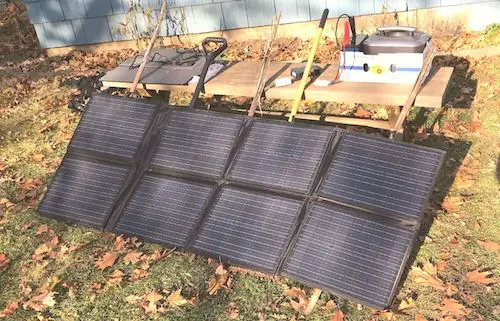

The type of solar panel that’s best for camping depends on where you intend to mount the panel.
- If you intend to lay the solar panel on the ground, then a portable/foldable solar panel with a kickstand is usually the best choice.
- If you can attach a solar panel onto your car’s side or on its roof, then a solar blanket, portable solar panel, or flexible solar panel can be mounted on one of these areas.
- If you have a rooftop tent with a hard tent surface, you can usually mount flexible solar panels on these surfaces.
No matter the case, finding a lightweight panel can make it much easier to mount and use throughout the day than heavier/bulkier panels.
How do portable solar panels for camping work?
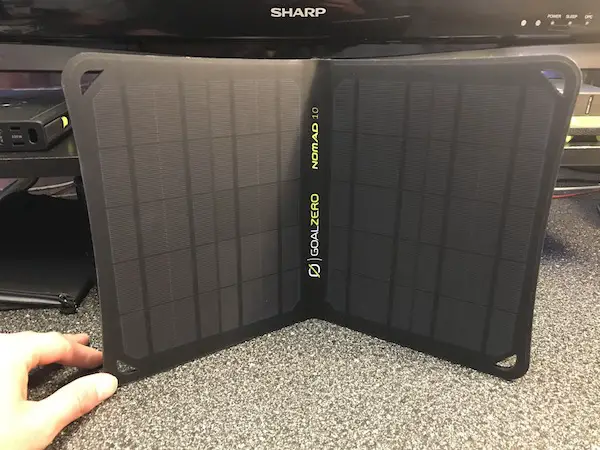
Portable solar panels for camping work by using USB ports, DC outputs, or both to power devices and/or portable power stations. All are foldable for easy carriage and tend to have a kickstand and/or hanging loops/grommets for mounting on the ground, a vehicle, or other objects.
Portable panels under 50W usually have only USB ports for charging small devices, while ones over 50W typically include high-powered DC outputs for charging portable power stations or 12V batteries.
Most solar panels under 30W can be mounted on the back of a backpack to charge devices while hiking.
Are solar blankets good for camping?
Solar blankets are good for camping if the sun is directly overhead (for ground use) and/or if they are mounted on the side, top, or windshield of a vehicle. Most solar blankets don’t have kickstands, so they can’t be angled by themselves. They usually have grommets or loops for mounting.
The angle of a solar panel is important for gathering as much solar energy as possible.
I tested my Atem Power 200W solar blanket both at an angle and lying flat on the ground and found that the output was completely different.
This had to do with the sun’s location, and you can read more about it in my review of the Atem Power.
I made a video review of it as well found below.
How do I choose a solar panel for camping?
Choosing the right solar panel depends on your camping style.
A portable solar panel with a kickstand helps you angle the panel on the ground to maximize its output. A solar blanket or flexible solar panel can be easily mounted on the vehicle. Determining the right solar panel wattage depends on what you’re powering while camping.
Some portable solar panels come with USB ports for charging small devices like phones, whereas most flexible solar panels only have one output cable to recharge batteries.
What should I look for when buying a portable solar panel?
1. Connectors
When using a solar panel to charge something up, you want to look and see if it comes with more than one type of connector.
By connector, I’m referring to connectors to charge certain types of devices like laptops, battery packs, solar generators, and the like.

Some portable solar panels have several types of connectors for a variety of uses and utilities, but these are usually only available when you want a solar panel that is higher than 50 watts.
The reason why is that most people are only looking to charge smaller devices with a small solar panel. I’m referring to phones, small battery packs, and lights, just to name a few.
Larger solar panels can support connecting to several different sources that require more power.
When looking for a solar panel, ask yourself what you intend to charge with it, and if they’re mostly small devices, you should be set on anything under 50 watts.
Most small devices use USB ports or micro USB ports, and nearly all portable solar panels under 50W have at least one USB port.
If you’re looking for a solar panel specifically to recharge your cell phone, I have a post where I give my top three choices along with several answered FAQs on this topic.
2. Kickstand
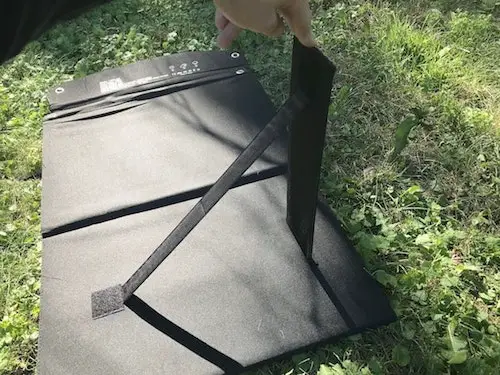
Having a kickstand on a portable solar panel isn’t a necessity, but it is a great asset to have when outdoors.
At a campsite, a kickstand is excellent because it makes it easy to angle it towards the sun.
A lot of people like to use portable solar panels when backpacking or hiking, and a kickstand obviously isn’t needed then because you can strap the panel on the back of your backpack, so it charges your devices up while you’re moving about.
But kickstands are excellent for people using the panels while stagnant, for example, camping, tailgating, while on a boat, etc.
3. Waterproofing
Some portable solar panels are more waterproof than others. This is a great feature to look into when shopping for panels for obvious reasons.
Whether labeled as “waterproof” or “water-resistant”, solar panels have different protection ratings and other factors like intrusion protection. When reviewing the solar panel you want online or in a store, find out its actual IP rating.
For example, on Amazon.com, the Wildtek Source 21W solar panel has an IP rating of 65 (seen as IP65), which means it is totally protected against dust and also is protected against low-pressure jets of water from all directions.
4. Handle

A carrying handle is usually for solar panels larger than 50 watts because anything lower than that is typically foldable and can fit in your backpack.
But for people looking for a panel with 50+ watts, a carrying handle is a necessity. This characteristic is often overlooked and is definitely underrated.
A carrying handle on a solar panel lets you carry it easily to wherever you need to go. Any handle is great, but the best ones are rubberized.
5. Pouch
Nearly all portable solar panels have a pouch to carry your devices and/or charging cables in, but some don’t. Make sure that you get one that has a pouch because it makes it easier to utilize.
This is especially useful if you like to keep everything in one area. A pouch isn’t necessary, of course, but it keeps things together when you need them.
6. Grommets
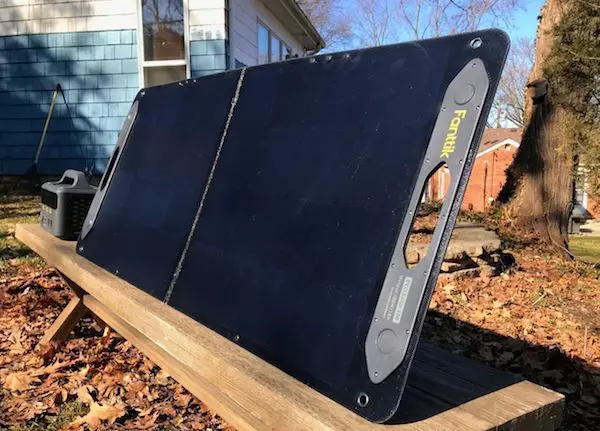
What are grommets? Grommets are little holes with metal or plastic rings located on the corners of some solar panels. Some portable solar panels have these and some don’t.
So why are these important? Because they allow you to attach your solar panel to a tent, tree, or even your vehicle so you can get a good angle towards the sun.
This feature makes your solar panel capable of charging in several different scenarios.
If needed, you can also use these holes to connect to your backpack if you want to charge on the go. Some solar panels have small loops on them for the same purpose, which are also very helpful.
Look out for grommets when solar panel shopping because they are easy to overlook, but they provide so much versatility for charging.
7. How Foldable Is It?
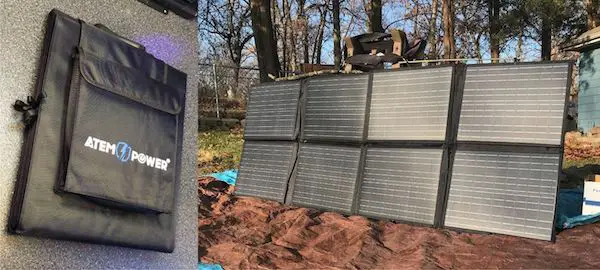
This is one of the most important factors to consider when looking into portable solar panels. Why? because you want it to be able to fit in a backpack or be able to be carried with ease.
Simply check the dimensions of the panel when reviewing it so you can get a good estimate of whether you can put it in a backpack or not.
Most portable solar panels that are less than 50 watts will be able to fit in a backpack.
If you intend to use the solar panel to charge devices up while hiking and want to hang it on the back of your backpack, make sure that when the panel is completely unfolded, it isn’t too long that it will be a nuisance.
8. How Large Is It Unfolded?
Solar panels with high wattages (50 to 100W+) will either unfold into a long rectangle or more of a square shape. This will not be useful while hiking but will be exceptional for static use (i.e. camping out).
Smaller portable solar panels usually unfold into a rectangle. Ones in the 25-40W range will usually have three separate solar cells that all fold together when wrapped up. In this case, most will be great for use while hiking.
9. Weight

Weight varies for portable solar panels. Some solar panels are high in wattage and weigh less than six pounds, but then some lower-wattage panels are heavier than the high-wattage ones.
This can be attributed to the solar panel cells themselves and the material used to bring the panels together.
If you intend to use the panels for backpacking and need to keep the overall weight as light as possible, comparing the weights of several solar panels can save you, in some cases, up to five pounds in your pack.
10. Wattage
As touched on at the beginning of this article, the type of portable solar panel that you need when hiking or backpacking is a smaller one between about 15-30 watts. This allows for a comfortable-sized panel that you can use on the back of your pack.
The ones that are 30W and greater are going to best be used when not moving around. They unfold to be much larger than the smaller ones, making them great for several activities because they can be easily transported.
A lot of companies sell large portable solar panels either in 60W format or 100W format. If you’re charging multiple devices, the 100W panels are the best choice.
11. What kind of outputs does it have?
Output ports on portable solar panels usually come with at least one USB port.
There are also ones that support USB-C and can charge more power-hungry devices.
Make sure that the panel’s ports have what you need, and also look into any smart chips or smart technology that comes installed with the ports.
Reminder: You likely won’t get the solar panel’s listed wattage
Every solar panel is rated in watts (W) of output power. This rating is telling you the maximum power of the panel under standard test conditions (STC), which is basically simulating perfect sunlight with no clouds, having the panel tilted at the perfect angle towards the sun, etc.
Because of weather changes, this wattage rating is likely unachievable in most real-life scenarios (especially for portable solar panels).
This means that for a 30W panel that’s placed with a nice angle towards the sun, even in great sunlight, you may be able to pull a maximum of 22-26W in reality.
If you’re using a solar panel to charge a solar generator, the power you receive from the panel depends on the type of charge controller that is inside the generator.
For example, a Jackery 1000 solar generator has an MPPT charge controller, which is the ideal controller type. The MPPT allows for efficient charging since it maximizes the solar panel’s output by capturing excess voltage (hence the acronym MPPT, which stands for Maximum Power Point Tracking).
A solar generator with a less efficient PWM charge controller tends to pull a lower wattage from the solar panel because it charges at the same voltage of the battery.
If you’re looking for any troubleshooting tips for your current or future portable solar panel, I have a guide that may give you some ideas on what to look for in order to:
- Keep your panel working for a long time
- Get you panel working again
- Improve the output of your panel
Check out the article here: Portable Solar Panel Not Working – Troubleshooting Guide.


![[Upgraded]BigBlue 3 USB Ports 28W Solar Charger(5V/4.8A Max), Foldable Portable Solar Phone Charger with SunPower Solar Panel Compatible with iPhone 11/Xs/XS Max/XR/X/8/7, iPad, Samsung Galaxy LG etc.](https://m.media-amazon.com/images/I/41p-j2XWwIL._SL500_.jpg)




![[Upgraded]BigBlue 3 USB Ports 28W Solar Charger(5V/4.8A Max), Foldable Portable Solar Phone Charger with SunPower Solar Panel Compatible with iPhone 11/Xs/XS Max/XR/X/8/7, iPad, Samsung Galaxy LG etc.](https://m.media-amazon.com/images/I/51TzbjSYA0L._SL500_.jpg)
